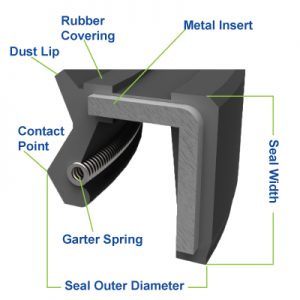 Expert advice from Daemar on how to select shaft seals
Expert advice from Daemar on how to select shaft seals
August 21, 2018 REDWIRE is news you can use from leading suppliers. Powered by FRASERS.
Posted by Daemar Inc.
Daemar manages the sourcing and delivery of millions of Essential Components to the manufacturing and MRO marketplace. I... Read more
Subscribe
Free REDWIRE e-newsletter

Choosing the right shaft seal is vital to extending bearing life.
Daemar Inc. is renowned across Canada for its unmatched inventory of essential industrial components. But Daemar is not merely a supplier of great products; it is also a team of experts who can assist clients with finding items that suit their applications – like shaft seals.
A recent blog entry by the company offers the team’s advice on how to extend shaft-seal life by choosing wisely.
Understanding the workplace demands
Proper selection of rotary shaft seals plays a strong role in bearing longevity and decreasing maintenance expenses for gearboxes, pumps, and motors. These seals not only retain system lubricants to enable operation with optimal levels of lubrication, but also exclude contaminants from entering systems and causing bearing failure.
According to Daemar, manufacturers need to assess the demands of their operating environments before choosing shaft seals. It is critical to consider these factors:
- Operating temperature for the seal;
- Pressure;
- Fluid compatibility with the lubricant and process fluid;
- Type of shaft motion;
- Shaft eccentricity and surface speed;
- Contaminants in the work environment;
- Geometry of the shaft and housing bore; and
- Shaft hardness and surface finish.
The next step is to determine the specifications for the seal’s individual elements, based on application data. A shaft seal must create a seal between a rotary component and stationary component, or between components in relative motion, to accomplish its intended goal successfully.
Material and design are important to consider. Each component of a shaft seal contributes to its overall effectiveness. The casing provides structure and rigidity while creating a static seal with the bore, usually built of carbon steel, and the sealing lip and garter spring maintain a dynamic seal with the shaft. The most compatible elastomer should be chosen according to the workplace assessment. The correct spring and geometry of the lip can help reduce friction and minimize wear.
After choosing the right seal, the user must learn proper installation procedure, to avoid future seal failure. The shaft and bore must have lead in chamfers and be free of sharp edges and burrs.
To learn more, contact Daemar.
Share
Posted by Daemar Inc.
Daemar manages the sourcing and delivery of millions of Essential Components to the manufacturing and MRO marketplace. I... Read more
